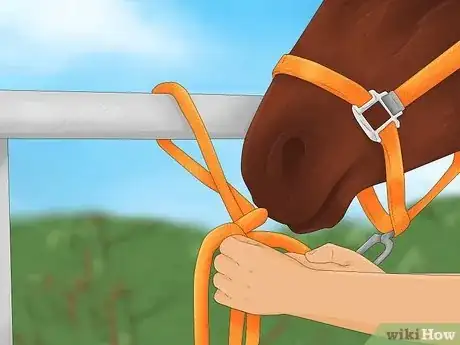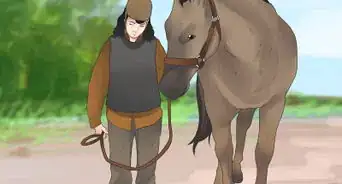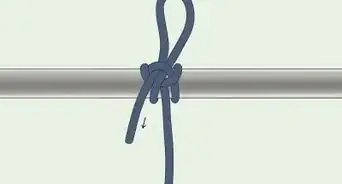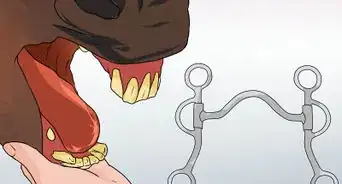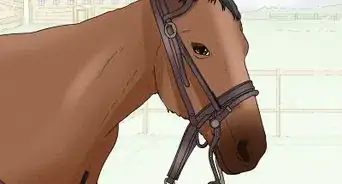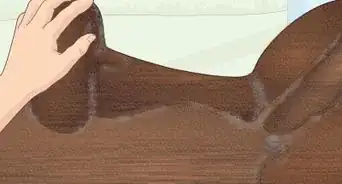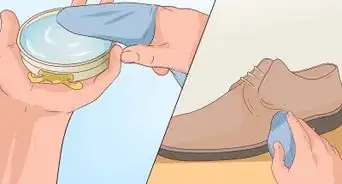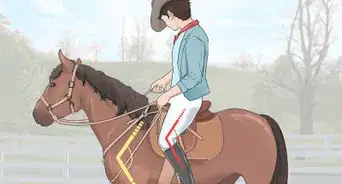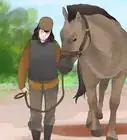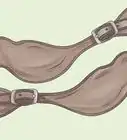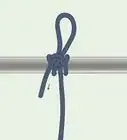This article was co-authored by Ryan Corrigan, LVT, VTS-EVN. Ryan Corrigan is a Licensed Veterinary Technician in California. She received her Bachelor of Science in Veterinary Technology from Purdue University in 2010. She is also a Member of the Academy of Equine Veterinary Nursing Technicians since 2011.
wikiHow marks an article as reader-approved once it receives enough positive feedback. In this case, 100% of readers who voted found the article helpful, earning it our reader-approved status.
This article has been viewed 119,579 times.
Western saddles are typically made of leather, built for riding over long periods of time while herding cattle or doing other ranch work. They tend to be heavier than English saddles, due to the materials used, and the Western rider can hold both of the reins in one hand, instead of holding one in each hand with the English model. But perhaps the biggest difference is that the Western saddle is designed to distribute the rider's weight more evenly. This makes it more comfortable for horses to carry riders over long distances for prolonged periods of time.[1] Knowing how to properly saddle a horse is important, both for the rider's safety and for the comfort of the horse.
Steps
Preparing Your Horse
-
1Groom your horse. Before you strap a saddle on your horse, it's important to ensure that your horse's mane/tail and hooves are clean, and that it does not have any sores on his skin. Pay special attention to the areas the tack touches, such as along the pressure points of the saddle or the area where the girth will go around the belly. If you leave dirt under the tack, it may cause skin irritation, hair loss or sores.
- Use a curry comb to detangle dirt, mud, and any other debris that might be matted in your horse's hair. Do not use the curry comb over any bony parts of the horse's body, as these may be more sensitive and could be injured by aggressive combing. Do not curry comb the neck and face. [2]
- Use a stiff-bristled body brush, also called the dandy brush, to continue dislodging hard-to-remove debris and remove the debris you've already dislodged. You can use this brush on the neck, chest, and legs. [3]
- Use a soft brush to gently flick away the debris removed by the curry comb and the body brush. Use this brush to do the face and legs.[4]
- Use a hoof pick to clean your horse's feet. In order to do this, lean against the side of your horse, be sure you aren't facing the legs and back of the horse so it wont be able to be kicked, and squeeze the horse's leg along the tendons which run right above the fetlock that you want lifted. Then, hold the hoof wall as you pick out the dirt, manure and rocks from the horse's hoof. Additionally, check the hooves for foreign bodies. Do this for all four hooves.
- Finish things off by gently wiping down your horse's face and body with a clean grooming cloth.[5]
-
2Check your gear. Look for worn areas in the leather or damaged buckles. Make sure there aren't any areas on the gear that may give out during your ride. Additionally, inspect the saddle and pad for any foreign objects that could cause irritation to your horse.Advertisement
-
3Set the saddle pad on your horse. It's important to position the saddle pad properly, as this will be the barrier between your saddle and the horse's skin.
- Put the saddle pad on the withers (shoulders), slightly forward of where you want it to end up. The saddling process will inevitably drag the saddle pad back, so starting slightly forward should allow the saddle and pad to end up where you want them. Never slide the saddle pad forward on your horse's back for you will cause the hair to go against the grain and make it uncomfortable for the horse.[6]
Securing the Saddle
-
1Grab the cinches, straps and stirrups. Lift the saddle in such a way that none of these attachments will get caught under the saddle.[7]
- The easiest way to keep your cinches, straps and stirrups out of the way is to cross them over the top of the saddle and put them around the horn. Keep them around the horn until you're ready to secure them.
-
2Lift the saddle onto your horse. If you have a hard time lifting the saddle, you may need to request assistance during this step.
- Stand next to your horse's left shoulder.
- Keep your feet shoulder-width apart, with your left foot near the horse's left hoof and your right foot slightly behind your left.
- Swing your torso and hoist the saddle up, so that your right arm ends up draped across the horse's back. This should land the saddle right on the saddle pad, on your horse's back.
-
3Lower the cinches and stirrups. Allow them to hang down across your horse, but make sure they're in the correct location for your ride. Adjust the cinches and stirrups so they're in the right place, if necessary.
-
4Make the horse put its left front hoof forward so the girth will be more comfortable. There are wrinkles in the front of your horse's girth area. Putting the front cinch (also called a girth) over the wrinkles can cause sores to develop. If your horse puts its left foot forward, the wrinkles will flatten out, making the girth more comfortable.[8]
-
5Secure the front cinch using a buckle or knot. Always Tighten the Cinch Before doing anything else on the saddle. Check that the cinch is flat against the horse's belly with no twists. Put your buckle in the correct holes and slide the buckle tongue through the cover. If you're using a knot, pull the latigo through the cinch ring until it is snug across the horse's belly. Then, put the latigo through the saddle D ring, moving from the outside in. Continue to wrap the latigo until it's tight on the horse.
-
6Tighten the back cinch if your saddle has one. It's important to keep the back cinch tight, as this will keep the saddle from lifting up during riding. (Some saddles do not have a back cinch. Despite what the picture depicts, please assure that the girth is hooked on before you start with the other cinches)[9]
-
7Attach the breast collar (if you use one). There are a number of different types of breast plate, and each one will require different assembly instructions.
- Ensure that the breast collar's center cinch strip is aligned with the center of your horse's pectorals.
- Thread the latigo from the left side through the ring on the end of the cinch and D ring twice.
- Pull tightly, then thread the latigo around the back of the D ring to the left, around front then back through. The end should then come through the middle of the D ring, and thread down behind the loop made (like tying a tie), pulling tightly again.
Making Final Preparations
-
1Pull out any skin that may have gotten trapped under the cinches. One way of doing this is by gently bending your horse's front two legs at the knees, stretching out the belly and freeing any flesh that may have been caught in the cinches.
-
2Untie your horse. Be sure that your saddle is properly attached before you untie your horse. Then put the bridal on.
-
3When you are training you may want to get the horse use to you getting on on both sides. Most horses are accustomed to being mounted from the left, but if you get the horse being use you getting on on both sides you wont have any problems. Before mounting, ALWAYS check the tightness of the cinch (or girth).
Warnings
- Place the saddle gently on the horse's back, trying not to drop it down too hard.⧼thumbs_response⧽
- Be sure there is a strap connecting the rear cinch to the front cinch, so that the rear cinch doesn't slide back, causing the horse discomfort. It can turn into a bucking strap real fast!⧼thumbs_response⧽
Things You'll Need
- Western saddle
- Horse
- Halter
- Lead Rope
- Saddle pad/blanket
- Grooming tools
References
- ↑ http://www.equisearch.com/article/differences-between-english-and-western-saddles-20068
- ↑ http://www.thehorse.com/articles/10028/grooming-your-horse-deep-down-clean
- ↑ http://www.thehorse.com/articles/10028/grooming-your-horse-deep-down-clean
- ↑ http://www.thehorse.com/articles/10028/grooming-your-horse-deep-down-clean
- ↑ http://www.thehorse.com/articles/10028/grooming-your-horse-deep-down-clean
- ↑ http://www.cowboyway.com/HowTo/SaddleAHorse.htm
- ↑ http://www.cowboyway.com/HowTo/SaddleAHorse.htm
- ↑ http://www.cowboyway.com/HowTo/SaddleAHorse2.htm
- ↑ http://www.cowboyway.com/HowTo/SaddleAHorse2.htm
About This Article
Before you put a Western saddle on a horse, lay a saddle pad on the horse’s shoulders. Stand on the horse’s left side and lift the saddle onto its back, then coax the horse to step forward with its front left leg so the buckle doesn’t cause sores. Tighten the front cinch until it’s snug against the horse, then the back cinch, if there is one. If you use a breast collar, attach it last. Check to make sure the horse doesn’t have any skin caught in the cinches before you mount it! Read on to learn how to check the saddle before you put it on the horse!











